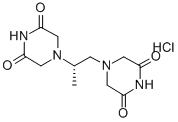SAFETY INFORMATION
| Signal word | Warning |
|---|---|
| Pictogram(s) |
 Exclamation Mark Irritant GHS07 |
| GHS Hazard Statements |
H315:Skin corrosion/irritation H319:Serious eye damage/eye irritation |
| Precautionary Statement Codes |
P280:Wear protective gloves/protective clothing/eye protection/face protection. P302+P352:IF ON SKIN: wash with plenty of soap and water. P305+P351+P338:IF IN EYES: Rinse cautiously with water for several minutes. Remove contact lenses, if present and easy to do. Continuerinsing. P332+P313:IF SKIN irritation occurs: Get medical advice/attention. P337+P313:IF eye irritation persists: Get medical advice/attention. |
COMPUTED DESCRIPTORS
| Molecular Weight | 304.73 g/mol |
|---|---|
| Hydrogen Bond Donor Count | 3 |
| Hydrogen Bond Acceptor Count | 6 |
| Rotatable Bond Count | 3 |
| Exact Mass | 304.0938327 g/mol |
| Monoisotopic Mass | 304.0938327 g/mol |
| Topological Polar Surface Area | 98.8 Ų |
| Heavy Atom Count | 20 |
| Formal Charge | 0 |
| Complexity | 404 |
| Isotope Atom Count | 0 |
| Defined Atom Stereocenter Count | 1 |
| Undefined Atom Stereocenter Count | 0 |
| Defined Bond Stereocenter Count | 0 |
| Undefined Bond Stereocenter Count | 0 |
| Covalently-Bonded Unit Count | 2 |
| Compound Is Canonicalized | Yes |
PRODUCT INTRODUCTION
description
Dexrazoxane Hydrochloride is the hydrochloride salt of a bisdioxopiperazine with iron-chelating, chemoprotective, cardioprotective, and antineoplastic activities. After hydrolysis to an active form that is similar to ethylenediaminetetraacetic acid (EDTA), dexrazoxane chelates iron, limiting the formation of free radical-generating anthracycline-iron complexes, which may minimize anthracycline-iron complex-mediated oxidative damage to cardiac and soft tissues. This agent also inhibits the catalytic activity of topoisomerase II, which may result in tumor cell growth inhibition.
